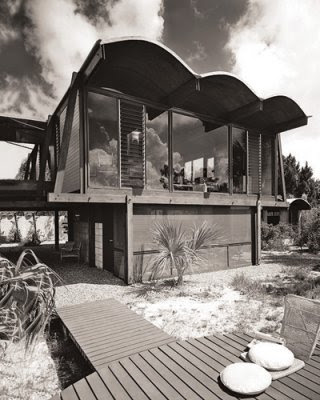







A half century ago, Paul Rudolph was considered postwar America’s best and brightest hope for the future. His early projects—a steady stream of houses, churches, and high schools in and around Sarasota, Florida—established his reputation for a nuanced and bold take on the International Style. At a time when cheap, watered-down modernism was the norm, Rudolph’s baroque interpretation of the style was hailed for its freshness and vision and its embrace of old and new.
Rudolph created soaring, dramatic spaces made from such sensuous-looking materials as ribbed concrete. He loved to puncture and soften modernism’s right angles with curves, arches, angles, and flourishes, while breathing new life into such old-fashioned concepts as grand entryways, brise-soleils, and sloping eaves. The architect had both the pragmatism of a city planner and the heedless impracticality of an artist—impulses that were sometimes at odds. His appointment in 1958 as the dean of the Yale School of Architecture, at the relatively young age of 40, only confirmed his messianic stature.
“In the 1960s he was everywhere,” says Timothy M. Rohan, an associate professor of art history at the University of Massachusetts at Amherst who is currently preparing a monograph on Rudolph. “You couldn't’t open an architectural journal without seeing him pictured or referenced or quoted on every other page.”
During Rudolph’s tenure, Yale’s architecture program became a design magnet, attracting (and teaching) a who’s who of soon-to- be titans, including Richard Rogers, Norman Foster, Robert A.M. Stern, and Charles Gwathmey. Rudolph designed a massive, sculptural home for the department, the Art & Architecture Building—a prototypical work of the fledgling Brutalist movement—which caused a sensation when it opened in 1963.
“It was the Bilbao of its moment,” says Stern. “It brought together diverse strands of modernism to create a new synthesis that was spatially inventive and tectonically powerful. One could see that it had its faults, but to me its strengths vastly overpowered them.” In New Haven and other cities Rudolph created a series of public-housing developments and municipal buildings—even, famously, a parking garage—that represented a new passion for and optimism about civic architecture. He left Yale to launch a private practice in 1965. But as the decade wore on, his fame and influence, coupled with his penchant for large-scale public projects, transformed him from upstart to establishment, a black mark in that tumultuous period.
Other issues contributed to Rudolph’s loss of status: the rise of postmodernism, which he hated; the end of enthusiasm for the ambitious government buildings he loved; the fact that he was gay in a predominantly straight industry. An ultraminimal Manhattan townhouse he designed received positive publicity when it later became the high-profile home of fashion designer Halston. But it wasn’t until the 1980s that Rudolph found a new fan base in Asia, designing office towers in Hong Kong and Jakarta.
These didn’t help his reputation at home, where his fall from grace was linked to his polarizing Yale building. Its standing sank among the student body; a mysterious fire that gutted it in 1969 galvanized the sentiment. A grudging renovation two years later ignored Rudolph’s design, blocking windows and skylights. “He would never talk about the building publicly,” recalls Stern. Meanwhile, his idiosyncratic houses in Florida and New England, built on choice lots but modest in scale, were frequently torn down to make way for hulking McMansions. Many of his public buildings are now threatened with demolition.
His death in 1997 had a final, bitter irony: He reportedly contracted mesothelioma from inhaling asbestos, which he used liberally. But the tide was beginning to turn. When Stern became dean of Yale’s architecture program, he restored the Art & Architecture Building to Rudolph’s original vision, and it was recently renamed Paul Rudolph Hall. In November 2010, landmark status was granted to Rudolph’s Beekman Place townhouse.
Stern points to the imagination and passion that Rudolph brought to design. “The computer has distanced architects from materials,” he says. Rudolph, on the other hand, “worked out every detail on paper, walking onto the site, working out the design as he remained in close contact with the construction. Students sense a certain lack in the methodologies of today. They miss—and I miss—that passion of Rudolph’s very much.”
Article from Elle Decor

No comments:
Post a Comment